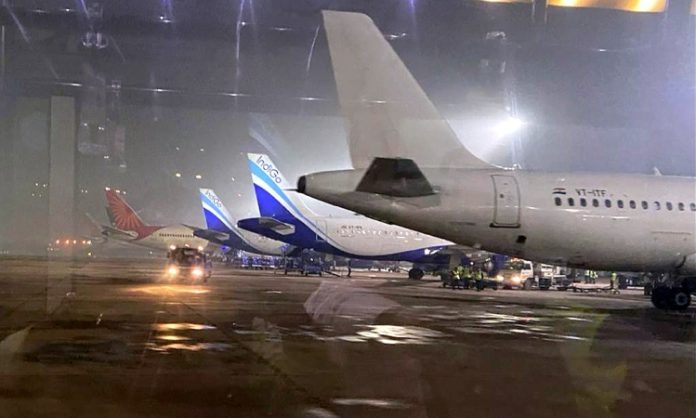New Delhi: Airlines officials and passengers on board two dozen flights had a harrowing experience on Sunday, when an anonymous person, through his social media handle, claimed there were bombs in the aircrafts.
With fresh threats issued for six flights each of IndiGo, Vistara, Akasa Air and Air India on Sunday, the number of hoax bomb calls received by Indian airlines this week through social media crossed at least 90.
Also Read: 1 dies, 30 injured as Singapore Airlines flight hits severe turbulence
Most of the threats are said to be issued an anonymous and unverified account —@schizophreniqqq— on social media platform X. The account was later suspended by X. The threat of bombs in the plane had forced one diversion and a few of the flights had to declare emergencies.
On Friday and Saturday, another anonymous X account —@adamlanza111— had posted threats to as many as 46 flights of Indian airlines before being taken down by the social media platform. These social media accounts are said to be created only recently, which is usually the case with social media accounts used to issue fake threats.
Also Read: 90% air travellers claim airlines compromised on comforts: Survey
Though most of the bomb threats turned out to be fake, airlines as well as aviation authorities globally take them with utmost seriousness. The security checks, which often take a few hours, result in disruptions like delays and even rescheduling of the remainder of the flight in some cases, which hit the airlines financially.
Vistara’s Delhi-Frankfurt flight UK27 returned to Delhi following the threat. The flight was just about to exit the Pakistani airspace on the way to Frankfurt when it turned around and headed back to Delhi, per flight tracking data.
Also Read: Japan Airlines flight hits static plane at Haneda airport, catches fire
Confirming the threat call, a Vistara spokesman said they had received security threat though social media for six flights operating on October 20. These flights include: Flight UK25 (Delhi to Frankfurt), Flight UK106 (Singapore to Mumbai), Flight UK146 (Bali to Delhi), Flight UK116 (Singapore to Delhi), Flight UK110 (Singapore to Pune), Flight UK107 (Mumbai to Singapore). “In line with the protocols, all relevant authorities were immediately notified, and security procedures, as directed by them, are being carried out,” he said.
Similar threats were received by the IndiGo and Akasa Air for six flights each. Though Air India did not comment on the issue, sources said that that at least six of the airline’s flights also received threats on Sunday.
Also Read: Airlines release winter schedule for Patna, no. of flights dips to 41
“We confirm that some Air India flights operating on 20 October were subject to security threats received on social media. Following the laid down protocols, relevant authorities were immediately alerted, and all security procedures strictly adhered to, as per guidance from the regulatory authorities and security agencies,” an Air India official said.
The IndiGo flights that received bomb threats were: 6E87 (Kozhikode-Dammam), 6E11 (Delhi-Istanbul), 6E17 (Mumbai-Istanbul), 6E58 (Jeddah-Mumbai), 6E112 (Goa-Ahmedabad), and 6E133 (Pune-Jodhpur). In similar statements issued for the affected flights, indigo said that all the passengers got off the planes safely and all standard operating procedures (SOPs) were followed in close coordination with the relevant authorities.
Also Read: Akasa Air to buy 150 planes to bolster domestic, international ops
The Akasa Air flights that received bomb threats on Sunday included QP1102 (Ahmedabad-Mumbai), QP1378 (Delhi-Goa), QP1385 (Mumbai-Bagdogra), QP1406 (Delhi-Hyderabad), QP1519 (Kochi-Mumbai), and QP1526 (Lucknow-Mumbai). After thorough security inspections of the aircraft, they were released for operations, according to the airline.
The airline immediately activated the Akasa Air Emergency Response team and initiated all standard operating procedures, including informing regulatory authorities and monitoring the situation in real-time. “Captains and crew members of respective flights followed the required emergency procedures, and prescribed safety and security protocols in coordination with the local authorities. The Airport Services teams at all impacted airports coordinated with local authorities to ensure efficient handling of the situation,” Akasa Air said.
Also Read: MoCA launches facial recognition boarding at Delhi, 2 more airports
Harried by the hoax threats, officials of the ministry of civil aviation (MoCA) and the ministry of home affairs (MHA) swung into action mode to trace and nab the individuals or groups behind these anonymous accounts. However, the use of virtual private networks (VPNs) by those positing the threats has made it challenging for the agencies. Government agencies are learnt to be in contact with social media platforms and VPN service providers to trace these threats.
Besides the domestic flights, three international flights of Indian carriers had also received hoax bomb threats. All major scheduled Indian carriers have received these bomb threats. One minor from Chhattisgarh was apprehended earlier this week in connection with the bomb threats issued on Monday. However, social media threats have continued and only risen over subsequent days.
Also Read: Tech snag forces Indigo flight to make emergency landing at Patna
MoCA is understood to be working closely with the Bureau of Civil Aviation Security (BCAS) to formalise an earlier proposal to ban from flying those behind bomb hoaxes. The government is also exploring changes in current rules and legislations to ensure stringent punishment for the culprits.
Even as it could be a hoax threat call, all related aircraft are deemed to undergo detailed security protocol, which could include diverting the aircraft to a suitable nearby airport and taking it to an isolated bay, where passengers are quickly made to deplane. The aircraft as well as passengers’ bags and the plane’s cargo are subject to a thorough security screening. After the screening and security checks, if the threat is found to be a hoax, the aircraft is released for operations.




